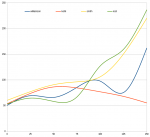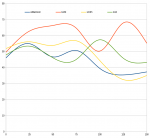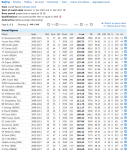Victor Ian
International Coach
If you were to tune into a test match and found a batsman on a particular score, how many more can you bank on them making, on average. All things being equal, then you can expect them to score their average. However, all things are not equal. Different batsmen perform differently once they get going. Take a look at the following. We can see that root performs quite poorly in comparison between 50 and 100 runs. However he then comes back with a vengeance, while Kohli performs badly thereafter in comparison to his peers.

I did a similar scenario for Tendulkar vs Lara, because we all know that Lara is king of staying in once he got going. As it turns out Tendulkar was better than him across the graph. It seems that not outs really hurt this analysis as they are more frequent in larger innings while larger innings become less frequent.
So basically, is there any use to such an analysis? Are there other better ways of looking at this kind of thing?
| 0 | 25 | 50 | 75 | 100 | 125 | 150 | |
| williamson | 50 | 69 | 66 | 85 | 97 | 75 | 162 |
| kohli | 53 | 73 | 86 | 84 | 76 | 68 | 55 |
| smith | 60 | 77 | 90 | 96 | 106 | 150 | 220 |
| root | 53 | 64 | 58 | 67 | 127 | 159 | 236 |

I did a similar scenario for Tendulkar vs Lara, because we all know that Lara is king of staying in once he got going. As it turns out Tendulkar was better than him across the graph. It seems that not outs really hurt this analysis as they are more frequent in larger innings while larger innings become less frequent.
So basically, is there any use to such an analysis? Are there other better ways of looking at this kind of thing?


